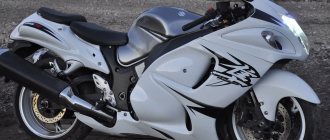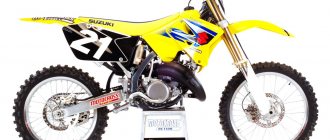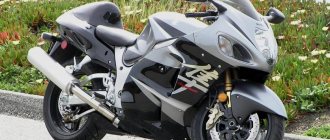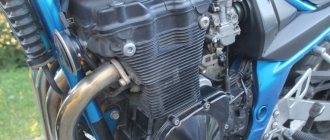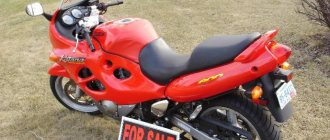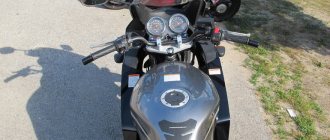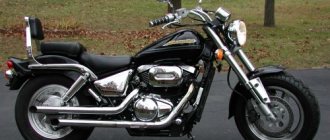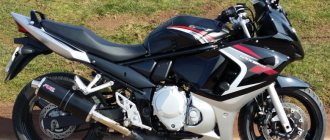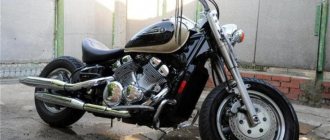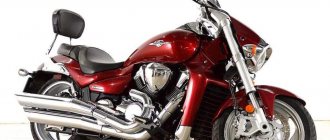The first presentation of Hayabusa (official name Suzuki GSX1300R Hayabusa) dates back to 1999. The company released it as a response to models from other Japanese manufacturers that claim to be the fastest bikes in the world. Before its appearance these were considered “ blackbird"(Honda CBR1100xx Blackbird) and ZX-11 Ninja (Kawasaki ZZR 1100).
Both models entered the market earlier, which allowed Suzuki engineers to study the experience of competitors, work on mistakes, negotiate with suppliers and release a motorcycle whose maximum speed was 312 km/h .
Peculiarities
Suzuki Hayabusa GSX1300R is today the fastest sports tourer that is approved for travel on public roads.
However, in time, the appearance of the model coincided with the agreement adopted between Japanese and European developers. Fearing sanctions from the world community, they made a decision - the maximum speed of bikes should not exceed 300 km/h, according to the speedometer.
In order not to kill the model in the bud, engineers installed a muffler , (which can be removed) to reduce power, as a result of which the bike's speed was limited to 299 km/h. For 7 years , Hayabusa had no competitors in terms of speed. In 2006, Kawasaki released the ZZR 1400, a model with increased cubic capacity, but according to the mentioned agreement, its speed remains the same ( 299 km/h ). Mechanics say that this muffler can also be removed. True, what the speed will be is not specified.
The release of Hayabusa continues . During production there was one generation change and a slight restyling, in 2008 and 2013 respectively .
Brief history of the model
- 1999 - start of production and sales. First generation.
Model:
Suzuki GSX1300R Hayabusa (Europe, North America, Australia).
Factory designation
: GSX1300RX.
- 2000 - no significant changes.
Model:
Suzuki GSX1300R Hayabusa (Europe, North America, Australia).
Factory designation
: GSX1300RY.
- 2001 - no significant changes.
Model:
Suzuki GSX1300R Hayabusa (Europe, North America, Australia).
Factory designation
: GSX1300RK1.
- 2002 - no significant changes.
Model:
Suzuki GSX1300R Hayabusa (Europe, North America, Australia).
Factory designation
: GSX1300RK2.
- 2003 - no significant changes.
Model:
Suzuki GSX1300R Hayabusa (Europe, North America, Australia).
Factory designation
: GSX1300RK3.
- 2004 - no significant changes.
Model:
Suzuki GSX1300R Hayabusa (Europe, North America, Australia).
Factory designation
: GSX1300RK4.
- 2005 - no significant changes.
Model:
Suzuki GSX1300R Hayabusa (Europe, North America, Australia).
Factory designation
: GSX1300RK5.
- 2006 - no significant changes.
Model:
Suzuki GSX1300R Hayabusa (Europe, North America, Australia).
Factory designation
: GSX1300RK6.
- 2007 - no significant changes.
Model:
Suzuki GSX1300R Hayabusa (Europe, North America, Australia).
Factory designation
: GSX1300RK7.
- 2008 - restyling of the model. Second generation
.
Model:
Suzuki GSX1300R Hayabusa (Europe, North America, Australia).
Factory designation
: GSX1300RK8.
- 2009 - no significant changes.
Model:
Suzuki GSX1300R Hayabusa (Europe, North America, Australia).
Factory designation
: GSX1300RK9.
- 2010 - no significant changes.
Model:
Suzuki GSX1300R Hayabusa (Europe, North America, Australia).
Factory designation
: GSX1300RL0.
- 2011 - no significant changes.
Model:
Suzuki GSX1300R Hayabusa (Europe, North America, Australia).
Factory designation
: GSX1300RL1.
- 2012 - no significant changes.
Model:
Suzuki GSX1300R Hayabusa (Europe, North America, Australia).
Factory designation
: GSX1300RL2.
- 2013 - minor changes to the model.
Model:
Suzuki GSX1300R Hayabusa + ABS (Europe, North America, Australia).
Factory designation
: GSX1300RL3 + GSX1300RAL3.
- 2014 - no significant changes.
Model:
Suzuki GSX1300R Hayabusa + ABS (Europe, North America, Australia).
Factory designation
: GSX1300RL4 + GSX1300RAL4.
- 2015 - no significant changes.
Model:
Suzuki GSX1300R Hayabusa + ABS (Europe, North America, Australia).
Factory designation
: GSX1300RL5 + GSX1300RAL5.
- 2016 - no significant changes.
Model:
Suzuki GSX1300R Hayabusa + ABS (Europe, North America, Australia).
Factory designation
: GSX1300RL6 + GSX1300RAL6.
- 2017 - no significant changes.
Model:
Suzuki GSX1300R Hayabusa ABS (Europe, North America, Australia).
Factory designation
: GSX1300RAL7.
- 2018 - no significant changes.
Model:
Suzuki GSX1300R Hayabusa ABS (Europe, North America, Australia).
Factory designation
: GSX1300RAL8.
- 2019 - no significant changes.
Model:
Suzuki GSX1300R Hayabusa ABS (North America, Australia).
Factory designation
: GSX1300RAL9.
- 2020 - no significant changes.
Model:
Suzuki GSX1300R Hayabusa ABS (North America, Australia).
Factory designation
: GSX1300RAM0.
- 2021 (2022) - restyling of the model. Third generation
.
Model:
Suzuki GSX1300R Hayabusa (North America, Australia, Europe).
Factory designation
: GSX1300RRQM2.
Specifications
The plastic body kit of the motorcycle hides a powerful in-line engine with 4 cylinders.
To improve the running parameters of the designer, we developed two solutions:
- SDTV - Suzuki Dual Throttle Valve . It is a pair of additional throttle valves in paired (1–2 and 3–4) cylinders. As the speed increases, they open, giving a significant increase in power. Electronics control.
- S-DMS - Suzuki Drive Mode Selector . Selecting the power delivery mode. The pilot has three maps available to him. A, B, C.
- Card A - full power, high quality.
- Card B - slightly reduces the return, allowing you to save fuel.
- Card C - power is cut by half. The developers recommend this option when driving in the rain or on compacted ground.
Switching between maps occurs using the selector on the right steering wheel.
Apart from this, the engine did not stand out in any way. 4 strokes, 4 cylinders placed in a row.
- Working volume - 1299 (1340) cm3.
- Power - 175 (197) hp.
- Number of valves - 4.
- Cooling is liquid.
- Fuel supply - injector.
- Ignition is transistorized.
- Start - electric starter.
- Fuel tank - 22 (21) l.
In brackets are the values after the generation change in 2008.
Transmission and clutch
The sprockets and main drive chain are consumables and require timely replacement.
The motorcycle is equipped with a 6-speed gearbox and a slipper clutch.
According to users, the box is very flexible, you can reach the limiter at 5, or you can drive around the city at 6 without breaking traffic rules.
Shifts well, pedal travel is within normal limits, neutral is immediately in place . The box doesn't create any problems.
- Clutch - multi-plate , oil bath, with slip elements. Power transmission is a cable.
- The main drive is chain .
Brakes
According to users, the first generation motorcycles had “cotton” brakes. When preparing the second for release, the designers took this opinion into account.
Front brakes.
Rear brakes.
For the new version of the caliper, the Japanese company Tokico . Instead of 6 pistons, they began to use 4, but placing them radially. According to the designers, this was supposed to solve the problem of “ vatness ”.
Front brakes
- Number of disks - 2.
- Disc diameter - 320 (310 from 2013) mm.
- Support - 6- (4-) piston.
Rear brakes
- Number of disks - 1.
- Disc diameter - 240 (260 from 2013) mm.
- Support - 1-piston.
Since 2013, the bike has received ABS, and the development of brakes has been transferred to the Italian company Brembo . The Italians also use 4-piston calipers, but in monobloc calipers .
Reviews
Reviews of Suzuki GSX1300R Hayabusa:
Expand Collapse
First departure. This is not true, I was just afraid to accelerate. the first gas slightly and the axle boxes or wheel rises slightly. In short, while I was practicing starting and braking in different ways, I wiped out the tires and the pads. I still have only good memories about this mot. fifth speed, the speedometer needle is on the limiter (after 280 there are 2 more bars and a limiter) on the tachometer 10500, I turn it up to 11000, turn on 6 and the speed increase continues until 6 hits the cutoff of 11000 at 6... and it feels like you’re not driving on the road and you’re already floating. indescribable feelings. I only matured to the maximum speed after 2 seasons of ownership. I tried it a couple of times before, but by 280 I changed my mind.
Mot has never failed. I drove 10k miles on it. fuel consumption - city 10 suburban 5-12 (how to drive) average 8. Among the consumables, I changed the fork seals (learned to ride in the rear) 1 time, pads 2 times, rear tires 3 times, oil 3 times and oil filter 2 times.
The moto is very comfortable. up to 230 you don’t feel the wind pressure even with a passenger. Trips on the track showed that the brakes are not sporty at all and there is a lot of weight. decided to sell.
After the jixer, I smiled from the comfortable suspension and more torquey and flexible engine. On it you can drive 160 km/h in 6th gear and the engine will whisper at 5100 rpm, or you can quickly accelerate to 300 without shifting down. The only biggest drawback is the constant speeding - imaginable and inconceivable (once I deliberately rolled under camera at the entrance to a populated area 250 km/h) A small drawback is the weak front brakes. It’s difficult to ride Busa slowly, she really loves long straights and smooth high-speed turns, she’s cramped in the city. She doesn’t notice climbs, nor does a passenger up to 60 kg)))))) A very interesting motorcycle, but not for beginners. If you make friends with him, understand and feel him, there will be no equals on the track in 99% of cases, the main thing is without fanaticism, although he constantly provokes: I can do more than you and everyone around me. Overtaking at any speed without problems. I never had the feeling of “I’ll have time or I won’t have time.” I remember back in 1999 I read the Hayabusa test in Klaxon and got the impression that you had to be at least a hereditary cosmonaut, or at least a test pilot, to pilot Businka, but everything turned out to be simpler - if you don’t be rude to her, then everything will be fine and predictable.
In two months I covered a little over eight thousand km. The speedometer went down several times - it was a rocket! The road surface leaves much to be desired; you can't speed up! You can ride this starlet in different ways as your heart desires - smoothly and softly, or you can also make a grip on the rear wheel. The engine is “evil” when needed or, on the contrary, soft. The suspension is excellent, swallows almost everything within reasonable limits. This “monster” constantly provokes me to twist the gas slowly, it’s not interesting, the result was the second rear ramp and the front brake pads. Consumables are not a problem - you can get everything. Oil and fuel consumption is normal - how will you twist it!! In the city it is easy to steer. On the highway it's a song! Doesn't like weakness, requires good physical shape and attention on the road especially in the city - children, opening doors, deceptive turns and other unpredictable “frames” in general, I really like the mot and all my friends - cool technique - a clot of adrenaline!!!!!!
Driving characteristics, fuel consumption
Before describing the speed, it is worth recalling that, according to the agreement, the bike is “stifled”, so the maximum speed declared by the manufacturers only partly corresponds to the true capabilities of the “bus”, as its owners affectionately call it.
According to factory documentation - 299 km/h. According to users, this mark can be reached in 5th gear. Switching to 6, the mark is easily jumped over.
Overclocking
Acceleration from zero to 100 km/h - 2.76 seconds . Again, according to users, it can be done faster.
Fuel consumption indicated by the developers is 5.88 liters per 100 km . Russian owners indicate the average as 8 liters , in the city up to 10 liters , on the highway no more than 6 liters .
So what will the 2022 Suzuki Hayabusa be like?
The third generation Hayabusa receives a huge number of improvements. This is not just an adjustment to a new environmental standard, but work on handling without sacrificing power. At the same time, the motorcycle remains recognizable externally. The manufacturer emphasizes that the design is aimed at improving aerodynamics.
Users can expect a new windshield and low-mounted, streamlined rearview mirrors. The chrome moldings catch the eye. Their V-shape represents energy, but actually diverts oncoming air away from the driver's feet.
The motorcycle will hit the market in three two-tone colors: black-gold, white-red, white-blue.
The passenger seat is installed higher than the driver's seat. And all for the sake of passenger convenience and improved visibility for him. For single drivers, you can install an “egoist” seat and install a plastic “tail” instead of the passenger seat.
Dimensions and weight
The generation change was reflected in all external parameters, with the exception of ground clearance and seat height.
The curb weight, with all fluids and a full tank, is 220 kg. for the second generation, 215 for the first. Dry, respectively - 198 kg, 192 kg.
Dimensions:
- in length - from 2,140 to 2,190 mm;
- in width - from 740 to 835 mm;
- also increased in height 1,155 to 1,165 mm ;
- The wheelbase has become smaller - from 1,485 to 1,480 mm .
Seat height - 805 mm .
Ground clearance - 120 mm .
Tuning
Oddly enough, Suzuki Hayabusa has become a favorite “field” for lovers of modifications. And it is difficult to single out a specific vector in which a custom bead is most often made. Often there are motorcycles converted for drag, then serious modifications to the engine are appropriate, including turbocharging, with the resource calculated for the race. Changes also apply to the suspension: travel is reduced, rigidity is increased, and the pendulum is lengthened to stabilize the motorcycle on a straight line.
Tuning the appearance has no boundaries. You come across beads converted into trikes. Street at its base is also not uncommon.
For whom is it intended?
A fairly high saddle means that motorcyclists of average and above average height can feel comfortable on the bike.
Only very experienced riders can cope with the wild nature of this sport bike.
The shorter ones should decide before purchasing - will they be able to swing a colossus weighing 200 kg in order to put their foot on the asphalt when they have to stop at a traffic light?
Price
For a new copy you will have to pay $16,500, which is within the range of other equipment of this class. For a used version in good condition, the price will start at $8,000, and this is quite interesting, since this is higher than the average market price for a sportbike.
Screenshot 1. Review of prices for used Suzuki GSX 1300 R Hayabusa motorcycles
Competitors
Hayabusa's strongest competitors are presented in the introduction. They were inferior in speed. 272 km/h - Kawasaki, 287 km/h - Honda.
Besides:
Honda CBR1100XX Blackbird.
Kawasaki ZZR 1100.
Honda CBR1100xx Blackbird
- 3 piston supports, support for combi-brake (engaging the rear when engaging the front and vice versa).
- The telescopic fork is of the usual type, there are no settings.
- The mono shock absorber has only two settings.
- Curb weight - 250 kg.
Kawasaki ZZR 1100
- Carburetor.
- Curb weight - 270 kg.
- Tank capacity - 24 l.
- Consumption - 5 l.
Exhaust is just a song
The exhaust system is symmetrical and uses an updated four-into-two-into-two design. Engineers hid high-precision catalysts in the midpipe and inside each muffler to keep emissions up to the requested standards.
The highlight will be the original solution. Manufacturers say that the color of the muffler housing will change depending on the owner’s driving habits. The appearance of its unique shade depends on how and how strongly the pipe is calcined.
Flaws
- Sluggish original brakes.
- Price.
and dignity
The appearance of the Suzuki Hayabusa evokes admiring glances both on city streets and on country roads.
- Despite the volume, you can shoot well between the rows .
- reliability.
- maneuverability and controllability.
